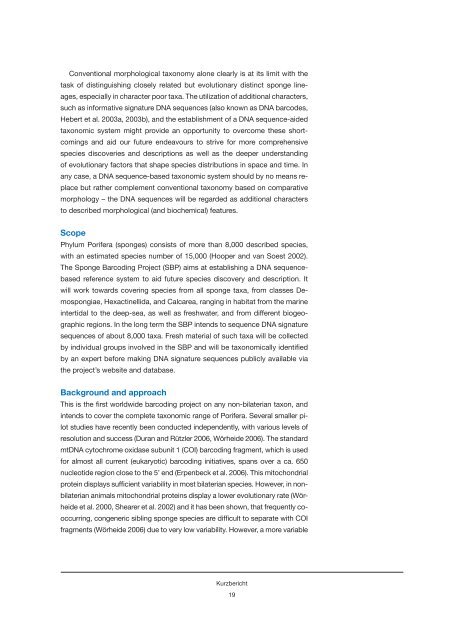GeoBio-CenterLMU Bericht 2008/2009 - Ludwig-Maximilians ...
GeoBio-CenterLMU Bericht 2008/2009 - Ludwig-Maximilians ...
GeoBio-CenterLMU Bericht 2008/2009 - Ludwig-Maximilians ...
Erfolgreiche ePaper selbst erstellen
Machen Sie aus Ihren PDF Publikationen ein blätterbares Flipbook mit unserer einzigartigen Google optimierten e-Paper Software.
Conventional morphological taxonomy alone clearly is at its limit with the<br />
task of distinguishing closely related but evolutionary distinct sponge line-<br />
ages, especially in character poor taxa. The utilization of additional characters,<br />
such as informative signature DNA sequences (also known as DNA barcodes,<br />
Hebert et al. 2003a, 2003b), and the establishment of a DNA sequence-aided<br />
taxonomic system might provide an opportunity to overcome these short-<br />
comings and aid our future endeavours to strive for more comprehensive<br />
species discoveries and descriptions as well as the deeper understanding<br />
of evolutionary factors that shape species distributions in space and time. In<br />
any case, a DNA sequence-based taxonomic system should by no means re-<br />
place but rather complement conventional taxonomy based on comparative<br />
morphology – the DNA sequences will be regarded as additional characters<br />
to described morphological (and biochemical) features.<br />
Scope<br />
Phylum Porifera (sponges) consists of more than 8,000 described species,<br />
with an estimated species number of 15,000 (Hooper and van Soest 2002).<br />
The Sponge Barcoding Project (SBP) aims at establishing a DNA sequence-<br />
based reference system to aid future species discovery and description. It<br />
will work towards covering species from all sponge taxa, from classes De-<br />
mospongiae, Hexactinellida, and Calcarea, ranging in habitat from the marine<br />
intertidal to the deep-sea, as well as freshwater, and from different biogeo-<br />
graphic regions. In the long term the SBP intends to sequence DNA signature<br />
sequences of about 8,000 taxa. Fresh material of such taxa will be collected<br />
by individual groups involved in the SBP and will be taxonomically identified<br />
by an expert before making DNA signature sequences publicly available via<br />
the project’s website and database.<br />
Background and approach<br />
This is the first worldwide barcoding project on any non-bilaterian taxon, and<br />
intends to cover the complete taxonomic range of Porifera. Several smaller pi-<br />
lot studies have recently been conducted independently, with various levels of<br />
resolution and success (Duran and Rützler 2006, Wörheide 2006). The standard<br />
mtDNA cytochrome oxidase subunit 1 (COI) barcoding fragment, which is used<br />
for almost all current (eukaryotic) barcoding initiatives, spans over a ca. 650<br />
nucleotide region close to the 5’ end (Erpenbeck et al. 2006). This mitochondrial<br />
protein displays sufficient variability in most bilaterian species. However, in non-<br />
bilaterian animals mitochondrial proteins display a lower evolutionary rate (Wör-<br />
heide et al. 2000, Shearer et al. 2002) and it has been shown, that frequently co-<br />
occurring, congeneric sibling sponge species are difficult to separate with COI<br />
fragments (Wörheide 2006) due to very low variability. However, a more variable<br />
Kurzbericht<br />
19


